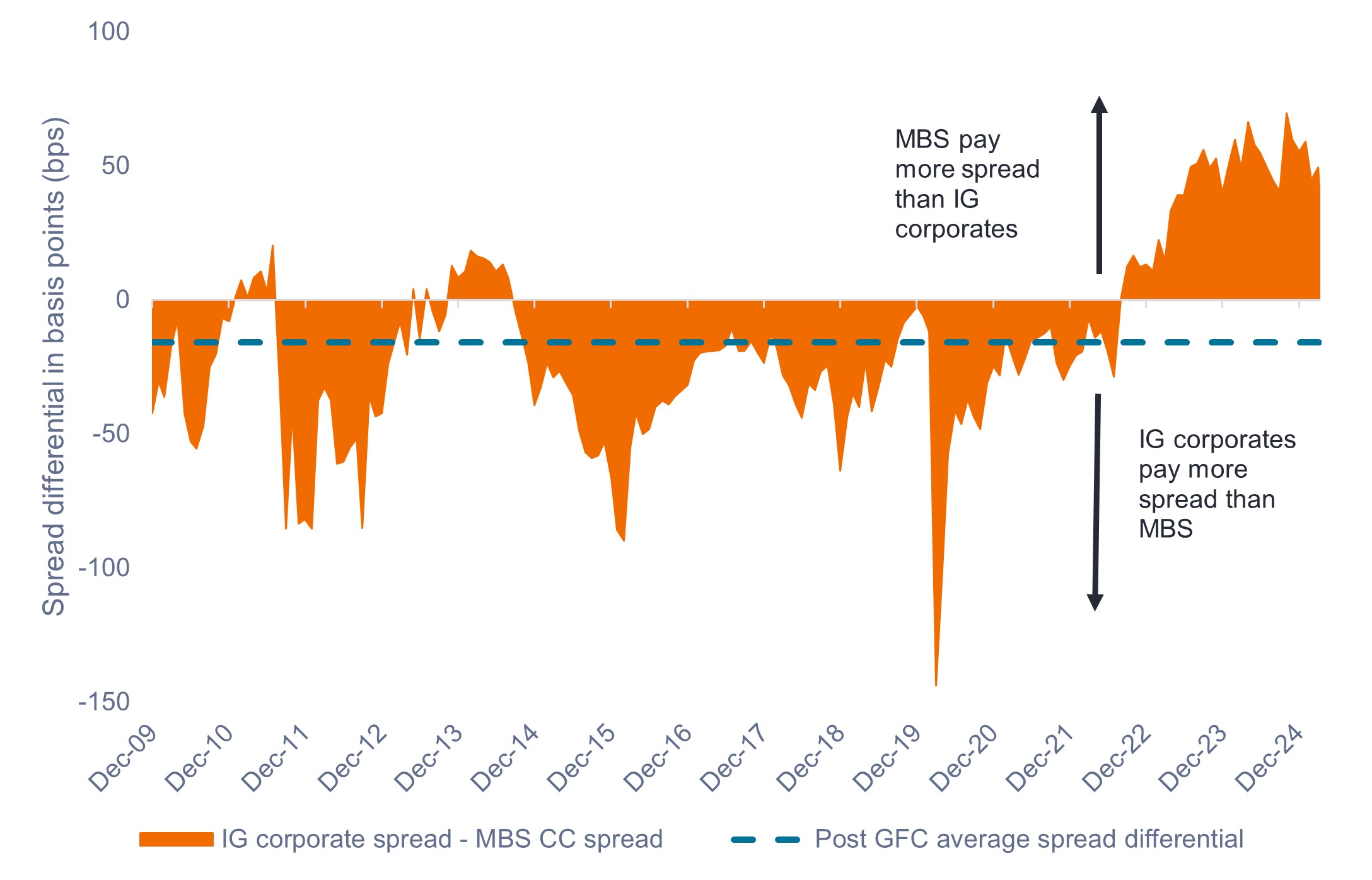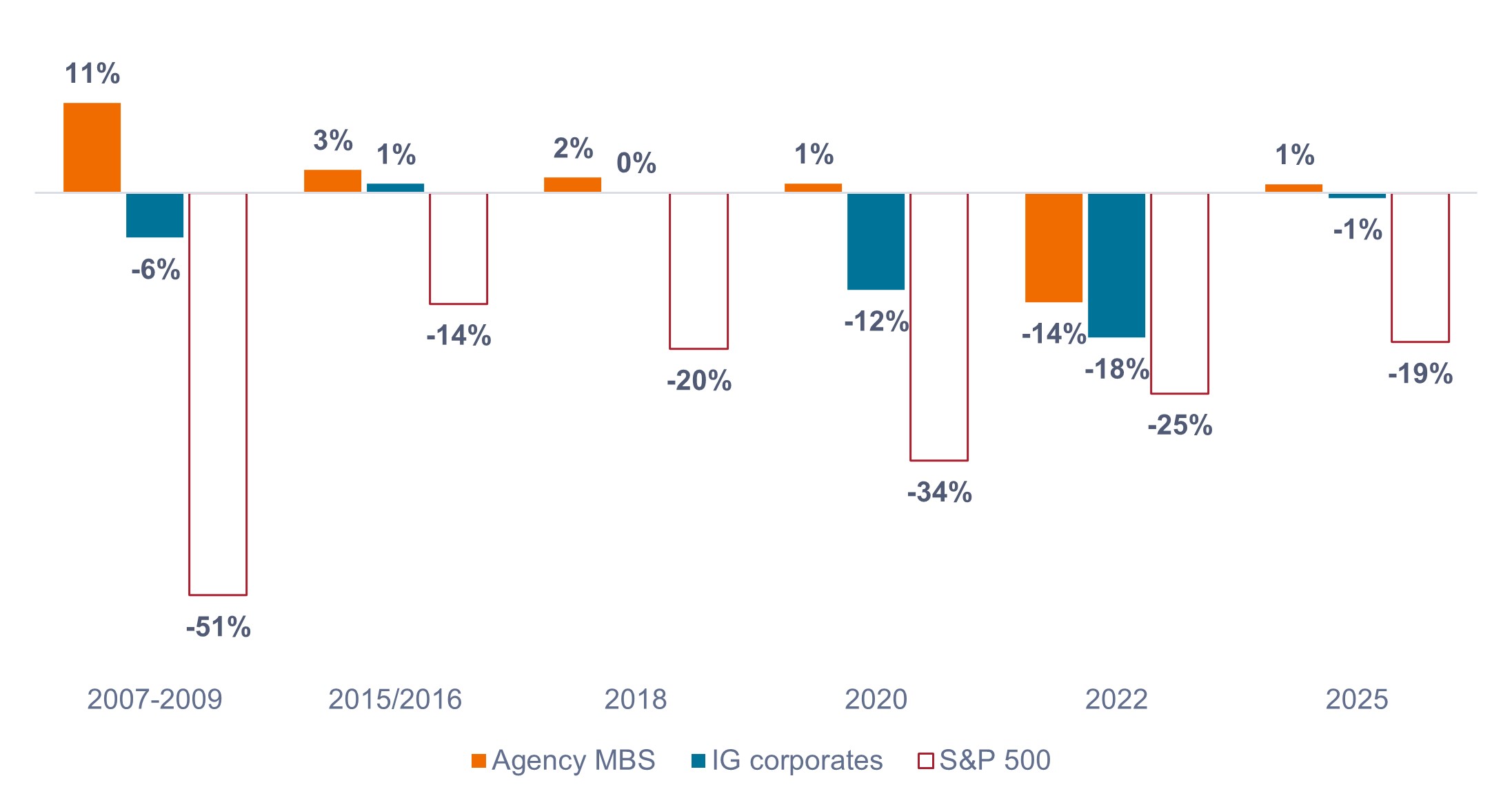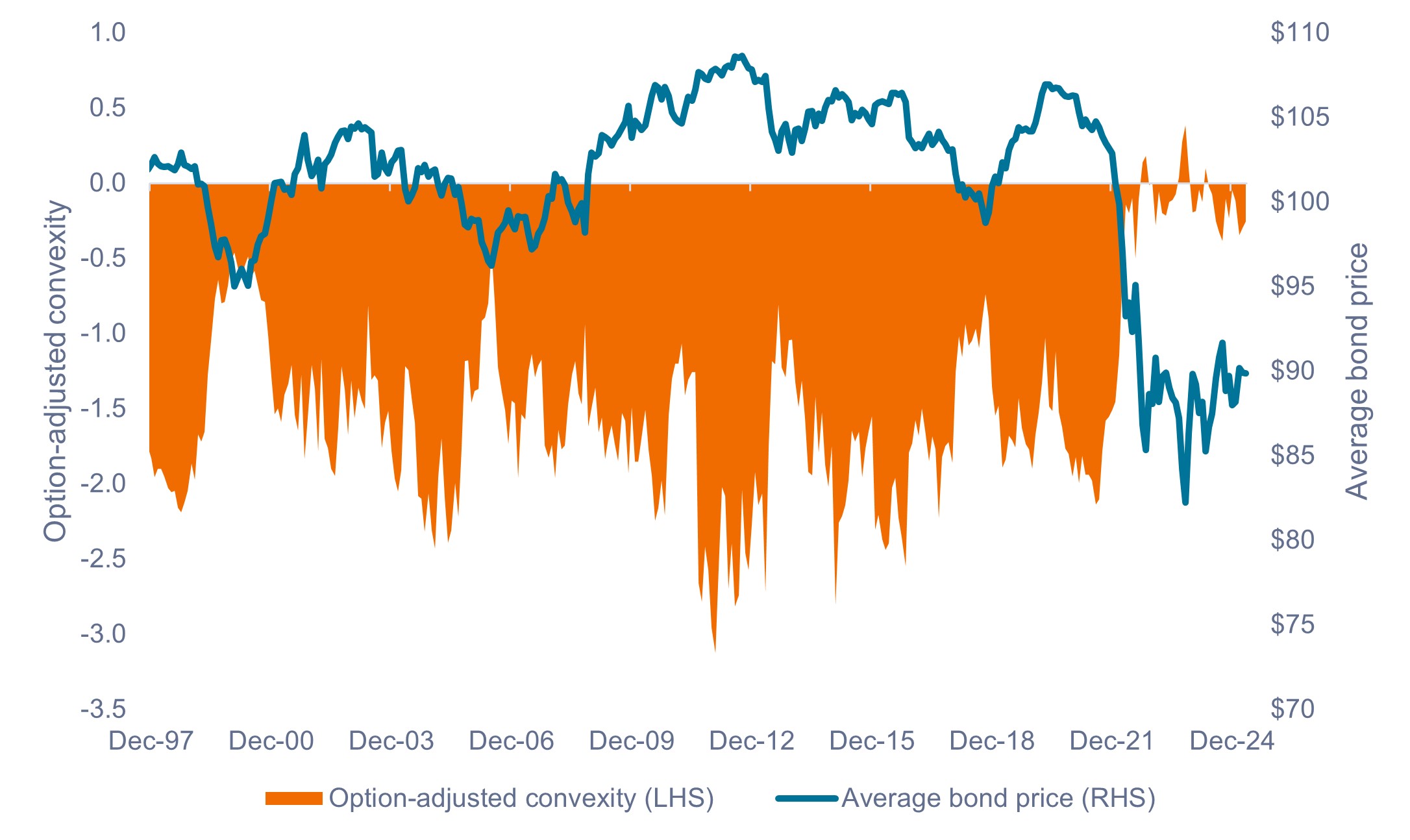Indicators flashing green for agency MBS?
Portfolio Managers John Kerschner, Nick Childs, and Thomas Polus highlight three reasons why agency mortgage-backed securities (MBS) look attractive in the present environment.

5 minute read
Key takeaways:
- While tariffs and trade negotiations have unsettled equity markets, agency MBS have quietly recorded their best start to a year since 2020, with the Bloomberg U.S. MBS Index up 3.35% year to date.1
- In our view, agency MBS continue to look attractive due to their relative cheapness versus investment-grade corporate bonds, their history of acting as a ballast when equity markets sell off, and their unusually low prepayment risk right now.
- We believe investors should consider capitalizing on the unique opportunity to buy agency MBS to add defensive duration to portfolios and lock in higher yields.
1 Through 30 April 2025.
Thus far in 2025, uncertainty has defined the narrative in financial markets amid the Trump administration’s tariff rollout and trade negotiations. While volatility has proliferated in equity markets, agency mortgage-backed securities (MBS) have quietly recorded their best start to a year since 2020, with the Bloomberg U.S. MBS Index up 3.35% year to date.2
We highlight three key reasons why we believe MBS continues to look attractive on both an absolute and relative basis.
1. Attractive valuations
Current coupon (CC) spreads on government-backed agency MBS have historically traded tighter than investment-grade (IG) corporates. Since 2022, however, agency MBS have paid a premium over IG corporates, as shown in Exhibit 1.
This phenomenon is largely due to recent strong demand-supply dynamics in the corporate sector, which have kept spread levels tight. Conversely, the MBS market has faced a more challenging supply backdrop due to quantitative tightening (QT), coupled with softer demand from banking institutions amid rising interest rates.
With QT drawing to a close and the Federal Reserve (Fed) well positioned for future rate cuts, we believe the anomalous spread differential is likely to unwind. In our view, the current valuation environment presents investors with an attractive relative value trade and a potentially lucrative entry point into MBS.
Exhibit 1: IG corporate credit spread less MBS CC spread (2009 – 2025)
Agency MBS spreads are at their most attractive levels relative to IG corporates since the Global Financial Crisis.

Source: Bloomberg, Credit Suisse, Janus Henderson Investors, as of 8 April 2025. Past performance does not predict future returns.
2. Defensive characteristics of agency MBS
Ongoing geopolitical tensions and disruptions to global trade are rattling equity investors, resulting in heightened volatility and an uptick in recession risk. Equity selloffs are not uncommon, and we recommend investors maintain a sufficient allocation to defensive assets to dampen equity market volatility.
As shown in Exhibit 2, agency MBS have historically acted as a ballast when equity markets have sold off, making it a suitable defensive diversifier, in our view. Agency MBS are backed by government-sponsored entities, which mitigates credit risk and adds high-quality duration to investment portfolios.
We believe their historical resilience during market selloffs positions agency MBS as a prudent choice for broad portfolio diversification and an insurance hedge given macroeconomic uncertainty.
Exhibit 2: Agency MBS vs. IG corporate returns through equity market corrections / bear markets
Agency MBS have meaningfully outperformed IG corporates in each of the last six equity market drawdowns.

Source: Bloomberg, as of 30 April 2025. Asset class descriptions and indices used to represent asset classes: S&P 500 = S&P 500® Index, Agency MBS = Bloomberg U.S. Mortgage-Backed Securities Index, IG corporates = Bloomberg U.S. Corporate Bond Index. Returns represent the total return for selected fixed income sectors for the periods corresponding with the five most recent peak to trough corrections / bear markets on the S&P 500 Index. Past performance does not predict future returns.
3. Historically low prepayment risk
Prepayment risk is the primary fundamental risk for agency MBS, as homeowners may pay off or refinance their mortgage at any point. Refinancing typically increases when interest rates fall and homeowners switch to lower-rate mortgages.
Prepayments result in the duration of MBS falling when interest rates decline, a concept known as negative convexity. Negatively convex bonds such as agency MBS may not fully capture the price appreciation from declining interest rates compared to positively convex bonds, whose duration rises when rates fall. To compensate investors for this risk, MBS pay an additional spread above the yield on comparable U.S. Treasuries.
Due to an extremely low-rate environment in 2020 and 2021, over 70% of existing U.S. mortgages were originated at interest rates below 5%. With the current mortgage rate still well above 6%, there is no financial incentive for most borrowers to refinance. As a result, the agency MBS market finds itself in an unusual situation where prepayment risk and negative convexity are around all-time lows.
The low level of prepayment risk is also reflected in the average bond price, which has been around all-time low levels since April 2022, as shown in Exhibit 3. We believe investors should consider capitalizing on the unique opportunity to buy agency MBS at negligible levels of prepayment risk.
Exhibit 3: Bloomberg U.S. MBS Index convexity and average bond price (1997 – 2025)
Prepayment risk, negative convexity, and average bond prices have been at all-time low levels since April 2022.

Source: Bloomberg, as of 30 April 2025. Past performance does not predict future returns.
Summary
In our view, the attractive relative value proposition, extremely low prepayment risk presently, and historical resilience during market selloffs support a tactical overweight to agency MBS for investors seeking to add defensive duration to portfolios and lock in higher yields.
IMPORTANT INFORMATION
Actively managed portfolios may fail to produce the intended results. No investment strategy can ensure a profit or eliminate the risk of loss.
Diversification neither assures a profit nor eliminates the risk of experiencing investment losses.
Fixed income securities are subject to interest rate, inflation, credit and default risk. The bond market is volatile. As interest rates rise, bond prices usually fall, and vice versa. The return of principal is not guaranteed, and prices may decline if an issuer fails to make timely payments or its credit strength weakens.
Mortgage-backed securities (MBS) may be more sensitive to interest rate changes. They are subject to extension risk, where borrowers extend the duration of their mortgages as interest rates rise, and prepayment risk, where borrowers pay off their mortgages earlier as interest rates fall. These risks may reduce returns.
2 Through 30 April 2025.
Bloomberg U.S. Mortgage-Backed Securities (MBS) Index measures the performance of U.S. fixed-rate agency mortgage backed pass-through securities.
Convexity demonstrates how the duration of a bond changes as the interest rate changes.
Credit Spread is the difference in yield between securities with similar maturity but different credit quality. Widening spreads generally indicate deteriorating creditworthiness of corporate borrowers, and narrowing indicate improving.
Duration measures a bond price’s sensitivity to changes in interest rates. The longer a bond’s duration, the higher its sensitivity to changes in interest rates and vice versa.
Monetary Policy refers to the policies of a central bank, aimed at influencing the level of inflation and growth in an economy. It includes controlling interest rates and the supply of money.
Quantitative tightening (QT) is a monetary policy where central banks reduce the amount of money in circulation by selling assets or allowing them to mature without reinvestment, effectively shrinking their balance sheet.
S&P 500® Index reflects U.S. large-cap equity performance and represents broad U.S. equity market performance.
Volatility measures risk using the dispersion of returns for a given investment.
Queste sono le opinioni dell'autore al momento della pubblicazione e possono differire da quelle di altri individui/team di Janus Henderson Investors. I riferimenti a singoli titoli non costituiscono una raccomandazione all'acquisto, alla vendita o alla detenzione di un titolo, di una strategia d'investimento o di un settore di mercato e non devono essere considerati redditizi. Janus Henderson Investors, le sue affiliate o i suoi dipendenti possono avere un’esposizione nei titoli citati.
Le performance passate non sono indicative dei rendimenti futuri. Tutti i dati dei rendimenti includono sia il reddito che le plusvalenze o le eventuali perdite ma sono al lordo dei costi delle commissioni dovuti al momento dell'emissione.
Le informazioni contenute in questo articolo non devono essere intese come una guida all'investimento.
Non vi è alcuna garanzia che le tendenze passate continuino o che le previsioni si realizzino.
Comunicazione di Marketing.
Important information
Please read the following important information regarding funds related to this article.
- Gli emittenti di obbligazioni (o di strumenti del mercato monetario) potrebbero non essere più in grado di pagare gli interessi o rimborsare il capitale, ovvero potrebbero non intendere più farlo. In tal caso, o qualora il mercato ritenga che ciò sia possibile, il valore dell'obbligazione scenderebbe.
- L’aumento (o la diminuzione) dei tassi d’interesse può influire in modo diverso su titoli diversi. Nello specifico, i valori delle obbligazioni si riducono di norma con l'aumentare dei tassi d'interesse. Questo rischio risulta di norma più significativo quando la scadenza di un investimento obbligazionario è a più lungo termine.
- Il Fondo investe in obbligazioni ad alto rendimento (non investment grade) che, sebbene offrano di norma un interesse superiore a quelle investment grade, sono più speculative e più sensibili a variazioni sfavorevoli delle condizioni di mercato.
- Alcune obbligazioni (obbligazioni callable) consentono ai loro emittenti il diritto di rimborsare anticipatamente il capitale o di estendere la scadenza. Gli emittenti possono esercitare tali diritti laddove li ritengano vantaggiosi e, di conseguenza, il valore del Fondo può esserne influenzato.
- Un Fondo che presenta un’esposizione elevata a un determinato paese o regione geografica comporta un livello maggiore di rischio rispetto a un Fondo più diversificato.
- Il Fondo potrebbe usare derivati al fine di conseguire il suo obiettivo d'investimento. Ciò potrebbe determinare una "leva", che potrebbe amplificare i risultati dell'investimento, e le perdite o i guadagni per il Fondo potrebbero superare il costo del derivato. I derivati comportano rischi aggiuntivi, in particolare il rischio che la controparte del derivato non adempia ai suoi obblighi contrattuali.
- Se il Fondo, o una sua classe di azioni con copertura, intende attenuare le fluttuazioni del tasso di cambio tra una valuta e la valuta di base, la stessa strategia di copertura potrebbe generare un effetto positivo o negativo sul valore del Fondo, a causa delle differenze di tasso d’interesse a breve termine tra le due valute.
- I titoli del Fondo potrebbero diventare difficili da valutare o da vendere al prezzo e con le tempistiche desiderati, specie in condizioni di mercato estreme con il prezzo delle attività in calo, aumentando il rischio di perdite sull'investimento.
- Il Fondo può sostenere un livello di costi di operazione più elevato per effetto dell’investimento su mercati caratterizzati da una minore attività di contrattazione o meno sviluppati rispetto a un fondo che investa su mercati più attivi/sviluppati.
- Le spese correnti possono essere prelevate, in tutto o in parte, dal capitale, il che potrebbe erodere il capitale o ridurne il potenziale di crescita.
- Il Fondo potrebbe perdere denaro se una controparte con la quale il Fondo effettua scambi non fosse più intenzionata ad adempiere ai propri obblighi, o a causa di un errore o di un ritardo nei processi operativi o di una negligenza di un fornitore terzo.
- Oltre al reddito, questa classe di azioni può distribuire plusvalenze di capitale realizzate e non realizzate e il capitale inizialmente investito. Sono dedotti dal capitale anche commissioni, oneri e spese. Entrambi i fattori possono comportare l’erosione del capitale e un potenziale ridotto di crescita del medesimo. Si richiama l’attenzione degli investitori anche sul fatto che le distribuzioni di tale natura possono essere trattate (e quindi imponibili) come reddito, secondo la legislazione fiscale locale.